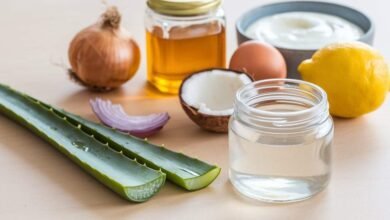Top 6 Benefits of Primose Oil For Skin.
Primrose oil, especially evening primrose oil, has been making waves in the skincare world as a go-to natural remedy for various skin concerns. Extracted from the seeds of the evening primrose plant, this oil is packed with gamma-linolenic acid (GLA), a fatty acid that is believed to work wonders for skin health. Whether you’re dealing with dryness, acne, or simply want to add a glow to your complexion, primrose oil has plenty of benefits to offer. Let’s dive into what makes this oil so special and how you can use it in your skincare routine.
What is Evening Primrose Oil?
Evening primrose oil (EPO) comes from the seeds of the evening primrose plant, which is native to North America. The plant blooms in the evening, which is how it got its name. This oil is rich in essential fatty acids, particularly gamma-linolenic acid (GLA), an omega-6 fatty acid that the body can’t produce on its own. Fatty acids play a major role in keeping our skin healthy, helping to reduce inflammation, maintain hydration, and support the skin barrier.
Evening primrose oil can be used topically or taken as a supplement. When used on the skin, it is known for its ability to soothe, moisturize, and promote skin healing. Taken as an oral supplement, it may support skin health from the inside out.
Why is Primrose Oil Good for Skin?
Let’s explore some of the amazing ways primrose oil benefits the skin:
1. Deep Hydration for Dry Skin
Primrose oil is known for its ability to lock in moisture. Thanks to its high fatty acid content, it forms a protective layer on the skin that helps prevent water loss. This makes it an excellent choice for people with dry or sensitive skin. Applying primrose oil can help restore the skin’s moisture balance, leaving it soft and smooth.
Many moisturizers and serums now include evening primrose oil as an ingredient because of its hydrating properties. For an extra boost, you can apply a few drops of pure primrose oil to dry areas, like cheeks and forehead, or mix it into your favorite moisturizer for added hydration. Moreover, If you want to know how I achieve flat belly and glowing skin. Click Here
2. Reduces Inflammation and Soothes Skin Conditions
The gamma-linolenic acid in primrose oil has powerful anti-inflammatory properties. This makes it effective for soothing skin conditions like eczema, psoriasis, and rosacea, which are often accompanied by redness, swelling, and discomfort. By reducing inflammation, primrose oil can calm irritated skin, reduce itchiness, and promote faster healing.
If you experience flare-ups of these conditions, applying primrose oil to the affected areas can help alleviate symptoms. It’s a gentle, natural way to provide relief without relying on strong medications.
3. Improves Skin Elasticity and Reduces Fine Lines
As we age, our skin gradually loses elasticity, which can lead to sagging and the formation of fine lines and wrinkles. The fatty acids in primrose oil help strengthen the skin’s barrier, making it more resilient and elastic. Regular use of primrose oil can give your skin a firmer, plumper appearance.
Primrose oil supports collagen production, which is essential for maintaining skin elasticity. Collagen is a protein that keeps our skin looking youthful and firm. By applying primrose oil, you can help maintain collagen levels in the skin, making it a valuable addition to an anti-aging skincare routine.
4. Fights Acne and Reduces Breakouts
One of the most popular uses for evening primrose oil is for treating acne. Acne is often caused by an overproduction of sebum (oil) and inflammation. The anti-inflammatory properties of primrose oil make it effective for calming inflamed acne, reducing redness, and promoting healing. Additionally, evening primrose oil can help balance hormone levels, which may be helpful for those who experience hormonal acne.
Some people even take evening primrose oil supplements to help manage acne from the inside out. When used topically, it’s best to apply a small amount to affected areas. It’s non-comedogenic, meaning it won’t clog pores, which is important for acne-prone skin.
5. Balances Skin Tone and Reduces Dark Spots
Evening primrose oil can help improve skin tone and reduce the appearance of dark spots or hyperpigmentation. Its ability to support healthy skin cell turnover means that old, damaged cells are replaced with new, fresh cells more quickly. This process can lead to a more even complexion and a brighter, clearer appearance over time.
For people who spend a lot of time in the sun or experience hormonal changes, dark spots and uneven skin tone are common issues. Primrose oil’s skin-renewing properties make it an ideal choice for anyone looking to achieve a more uniform skin tone.
6. Soothes Eczema and Other Skin Conditions
For those with eczema or similar skin conditions, primrose oil is a lifesaver. Its GLA content helps reduce itching, redness, and flakiness, which are common symptoms of eczema. Regular application of primrose oil may provide relief from discomfort and help prevent flare-ups.
A study has shown that GLA can improve skin barrier function, which is often compromised in people with eczema. Adding primrose oil to your skincare routine may offer a natural, gentle way to manage eczema symptoms.
7. Supports Overall Skin Health
Primrose oil’s unique blend of fatty acids also supports the skin’s natural barrier. This barrier helps keep out harmful bacteria and pollutants while retaining moisture. By strengthening this barrier, primrose oil promotes overall skin health, keeping it resilient against environmental damage.
How to Use Primrose Oil for Skin
Now that you know the benefits, here are some easy ways to incorporate primrose oil into your skincare routine:
1. Direct Application to the Skin
If you have specific dry or irritated areas, try applying a few drops of primrose oil directly to the skin. Gently massage it in with your fingertips until it’s absorbed. You can use this as part of your nighttime skincare routine.
2. Mixing with Your Moisturizer
For a hydration boost, mix a few drops of primrose oil into your daily moisturizer. This can enhance the moisturizer’s ability to keep your skin soft and supple, especially in colder months when skin tends to dry out more quickly.
3. DIY Primrose Oil Mask
Primrose oil can be used in homemade face masks. Try mixing it with soothing ingredients like honey, yogurt, or aloe vera for a hydrating mask. Apply it to your face for 15-20 minutes, then rinse with warm water. This DIY mask is perfect for a pampering session and can leave your skin feeling refreshed.
4. Oral Supplement for Internal Benefits
Some people take evening primrose oil as an oral supplement to support skin health from within. Although more research is needed, some studies suggest that oral evening primrose oil may help with acne and dry skin conditions. It’s important to consult with a healthcare provider before starting any new supplements, especially if you have any medical conditions.
Possible Side Effects of Primrose Oil
While primrose oil is generally safe for most people, it’s always wise to do a patch test before applying it to a larger area, especially if you have sensitive skin. Place a small amount on your inner wrist and wait 24 hours to check for any reaction. Some people may experience mild irritation, so it’s essential to test beforehand.
If you’re pregnant, nursing, or taking medications, speak with a healthcare provider before using primrose oil, either topically or as a supplement.
FAQs About Primrose Oil for Skin
Q: How often should I use primrose oil on my skin?
A: You can use primrose oil daily or a few times a week, depending on your skin’s needs. Start with a small amount to see how your skin responds.
Q: Is primrose oil suitable for oily or acne-prone skin?
A: Yes, primrose oil is non-comedogenic, meaning it won’t clog pores. Its anti-inflammatory properties make it suitable for acne-prone skin as it helps reduce redness and inflammation.
Q: Can primrose oil help with acne scars?
A: Primrose oil promotes skin cell turnover, which can help reduce the appearance of acne scars over time. It may not completely erase scars, but it can improve overall skin texture.
Q: How long does it take to see results from using primrose oil?
A: Results vary from person to person. Some may notice softer, more hydrated skin within a few days, while it may take a few weeks to see improvements in acne or skin tone.
Q: Can I use primrose oil along with other skincare products?
A: Yes, primrose oil can be layered with other skincare products. It’s best used as the last step in your skincare routine to seal in moisture.






